Field Inspection of High-Density Polyethylene (HDPE) Storage Tanks Using Infrared Thermography and Ultrasonic Methods
Abstract
1. Introduction
2. Experiment Methodology
2.1. Temperature Collection
2.2. Infrared Thermography (IRT)
2.3. Ultrasonic Testing (UT)
2.4. Defects Created Inside the Tank
3. Results and Discussion
3.1. Temperature Collection
3.2. Infrared Thermography (IRT)
3.3. Impact of Camera Distance on the Defect Detection
3.4. Impact of the Angle of View on the Defect Detection
3.5. Impact of Heating Source Distance to the Tank on the Defect Detection
3.6. Ultrasonic Testing (UT)
3.7. Practical Guidelines for HDPE AST Integrity Evaluation
- Review prior formal and periodic inspections, and identify the locations that need closer inspection.
- Visually inspect the AST and look for any abnormality or unusual signs, such as cracking, crazing, brittle appearance, holes, dents, and abrasions.
- Visually check around the fittings, particularly focusing on the areas around the steel bolts. Check fittings, hoses, gaskets, and all connections for any signs of general corrosion (in steel bolts and gaskets), deterioration, or leaks. Note changes from the original design and installation information, if available.
- Walk around the AST and look for any deformation, buckling, or distortion. Pay attention to where the upper section of the wall meets the lower section of the wall, which is usually waist height. This connection separates the thicker wall in the lower section from the thinner wall in the upper section. Compare changes from the current inspection with the last inspection report.
- Look closely for signs of brittleness in the tank’s dome. Chemicals that produce fumes can cause the dome to oxidize and embrittle without being in direct contact with the brine solution. To avoid walking or standing on the dome surface, the evaluation of the dome should be completed by safety-certified personnel using lift equipment.
- Investigate the base of the AST to make sure it rests on a firm and even base. Animals can burrow underneath the AST, causing the base to settle unevenly. Note changes from the original design and installation information, if available.
- Use the IR camera without using the external heat source and walk around the AST to check for any anomalies that may interfere with the defect detection. If there is something on the external wall, wipe off the AST wall to remove any moisture and wait for at least 10 min until a uniform temperature forms on that area before starting the evaluation. In addition, pay attention to see if there is any leakage from the AST, especially close to fittings.
- Power on the external heat source, and allow it to reach maximum power. Record the ambient temperature, relative humidity, and wind speed. Measure the temperature of the liquid inside the AST, and measure the AST wall temperature at different spots to calculate a representative ∆T (ΔT = Twall_surface − Tliquid).
- If ∆T > 0, then IRT can be conducted. If the AST is located outdoors, then the best time frame for conducting the IRT evaluation is between 9:00 a.m. and 6:00 p.m., preferably between 2:00 p.m. and 6:00 p.m. ASTs located indoors can be inspected using IRT at any time of day.
- If ∆T < 0, then do not proceed with IRT investigations.
- Start the IRT experiment by selecting the heating–cooling combination according to the recommendations provided in Table 8.
- Heat the first area, and move to heat the next area. Heating successive areas limit downtime. While one area is in the cooling phase, perform IRT. When the cooling cycle is complete for the first area, return to it and begin heating it again. Repeat this procedure for five cycles in each area, and perform an IRT observation during each cooling phase. Mark areas that have potential subsurface defects based on the IRT inspection.
- Use ultrasonic instrumentation over the marked areas for a more detailed investigation. Move the PAUT probe vertically and diagonally in 15° angles left and right along the surface of the AST to detect subsurface defects. Measure the defect size and depth from the external surface.
3.8. Field Testing
3.9. IRT Challenges for the Field Evaluation of HDPE ASTs
- IRT can be used only as an indicator of the defects’ existence and does not provide information about the location and depth of the defects. Supplementary evaluation with UT can further assess the location and depth of defects. This is also true when using IRT on other materials.
- Defect detection accuracy highly depends on ambient weather conditions.
- IRT is not able to detect small defects (AR < 0.3) or very deep defects (D/t > 0.83).
- IRT is not able to detect non-leaking cracks propagated from the internal side of the AST towards the surface. This has been discussed in more details in Ref [9].
- IRT is labor intensive and requires personnel to heat areas in different cycles.
- IRT is time-consuming for HDPE ASTs, due to the material’s low thermal conductivity. The operator should be prepared with multiple charged batteries for the equipment.
- Using various IR cameras from various manufacturers or various models produced by the same manufacturer could affect the accuracy of defect detection.
- Water droplets due to rain, fog, or other activities close to the AST can interfere with defect detection.
- Because many sites will contain a number of ASTs that need to be inspected, this task can become tedious. Therefore, to expedite the evaluation process, the inspection can be limited to the lower sections of the AST (i.e., waist height and below) where failures are most frequently reported.
- IRT can be completed on the lower (i.e., waist-high and below) sections of the AST without the need for any additional equipment. If there is an accident or a concern close to the top of the AST, then the evaluation process may be challenging in the absence of hydraulic lifters or cranes.
- The IRT equipment needs to have access to electrical power. A portable generator is useful in the field.
- Appropriate electrical access for IRT is challenging to obtain. The heaters recommended for performing IRT have a large current draw and will trip most conventional circuits. It is recommended either to use two separate electrical sources or to use a sufficiently capable portable generator.
- The heaters used for IRT can reach extremely high temperatures. Careful consideration must be taken to ensure that the operator is properly insulated from the heat generated by the infrared heaters.
- To prevent fire or electrical hazards, it is recommended to turn off the heaters for 10 min every 20 min or for 15 min every 30 min. Aside from proper insulation, this is the best way to keep the heaters within a comfortable heat range for the operators. The authors recommend using stacked infrared heaters, such as those being used for paint curing, in order to reduce these hazards, keep the operator safe, and deposit a more uniform temperature on the area under study.
- Heating around the fittings is challenging and causes non-uniform heat deposits. Hoses connected to the outlets prevent the application of heat on the surface behind them. Moreover, heating these hoses may inadvertently cause damage to the hoses and gaskets.
- Since an operator is moving the heater, it is not guaranteed that exactly the same area heated during one cycle is being heated in the next cycle. There is likely to be a gap between the heated spots, as shown in Figure 18. Therefore, it is possible that some sections of the tank may be missed during the inspection.
- Discolorations, stains, superficial scratches, and information tags interfere with defect detection, which may reduce the speed of evaluation by numerous false detections.
3.10. UT Challenges for the Field Evaluation of HDPE ASTs
- Due to the AST wall curvature, all sides of the probe cannot be in contact with the AST wall, and therefore, the water leaks from the water probe. This can be solved by using a more powerful water pump. Note that the pump used in this study had an uninhibited flow rate of 23 L/min (6 gal/min); however, when tubing was used to attach the pump to the water wedge probe, the flow rate fell to 0.9 L/min (0.25 gal/min). In order to overcome this issue, a pump with a minimum uninhibited flow rate of 38 L/min (10 gal/min) is recommended to fill the water probe reservoir faster than the leakage discharge.
- Completing the PAUT on the upper section of the AST is difficult and requires a more powerful water pump to pump up the water to that elevation.
- The water pump requires electricity, so a portable generator may be required in the field.
- The water pump requires a consistent source of water, which can be accomplished by using a 5 gal (19 L) bucket, although larger volumes of water may be needed for longer inspections.
- The measurement should be done by moving the probe up and down or by an angle of 15° compared to the vertical line. This reduces the water leaks from the water probe and helps obtain better results. Moving the probe in angles greater than 15° from the vertical line will result in more leakage due to the AST wall curvature.
- Completing PAUT on the cone-shaped outlets is impossible. In such cases, using traditional pulse-echo UT is recommended.
- During the manufacturing of some HDPE ASTs, the interior of the AST can have a wavy texture, as shown in Figure 19. This texture will increase the background noise and can interfere with the results. High amounts of waviness inside the AST may reduce the effectiveness of UT techniques since the wavy texture will scatter the ultrasonic waves. If the investigator does not have enough experience with evaluating HDPE ASTs, then the waviness could mistakenly be reported as a defect. In such cases, the UT is still useful since it can detect areas where the wall thickness is less than the thickness mentioned in the AST specifications.
- UT methods, both pulse-echo UT and PAUT, are dependent on the temperature of the element being inspected. If UT is performed after IRT, then the UT equipment must be recalibrated to the new material temperature to generate accurate results. If it is desired to avoid recalibration, then UT can be performed either before IRT or after sufficient time has elapsed to allow the material to return to the ambient temperature. Likewise, UT could be performed on a different day than IRT.
- The liquid inside the AST causes background noise in the returned signals, which may block some defect signal peaks. However, a skilled UT operator can differentiate the background noise to detect defects as small as 4.4 mm (0.17 in).
4. Conclusions
- The interaction of sample geometry, initial thermal gradient, defect location, and defect aspect ratio will impact the accuracy of IRT in detecting subsurface defects in HDPE ASTs.
- The distance of the camera to the tank, the angle of view, the heating source power, and the distance of the heating power to the tank will impact the accuracy of the IRT measurements.
- The best time for conducting IRT is on sunny days and between 9 a.m. to 6 p.m. Since the evaluation of the tank is time-consuming, the evaluation can be started from the east side in the morning and completed on the west side in the afternoon.
- Completing the IRT evaluation in the afternoon (after 2:30 p.m.), will provide a higher probability of detecting smaller defects for both the east and west sides.
- If ΔT < 0 °C (0 °F), then the accuracy of the defect detection diminishes dramatically. Therefore, it is not recommended to perform IRT if this condition exists.
- When the thickness of the tank is 12.7 mm (0.5 in) and ∆T > 6 °C (10.8 °F), 30 s of heating for five consequent intervals should be sufficient to allow the heat to penetrate the tank wall. The combination of 30–90 (30 s heating with 90 s cooling) is recommended when the thickness of the tank is 12.7 mm (0.5 in).
- When the thickness of the tank is 19.1 mm (0.75 in) and ∆T > 4 °C (7.2 °F), the heating–cooling combinations of 40–40, 40–80, or 40–120 are recommended.
- The recommended distance of the IR camera to the tank is between 0.5 m to 1.5 m (1.6 ft to 4.9 ft) and the recommended angle of view is between 0° to 30° relative to the direction perpendicular to the tank wall.
- In addition to IRT, PAUT can be utilized to examine HDPE ASTs in greater detail. PAUT was able to detect defects as small as 4.4 mm (0.17 in) in diameter in this study.
- The massive liquid inside the tank, the attenuation of sound in HDPE, and the waviness of the tank wall interior will increase the background noise in PAUT investigations and reduce the capability of defect detection and measurement by UT.
Supplementary Materials
Author Contributions
Funding
Data Availability Statement
Acknowledgments
Conflicts of Interest
References
- Wypych, G. Handbook of Polymers, 2nd ed.; ChemTec Publishing: Toronto, ON, Canada, 2016. [Google Scholar]
- Whitford, F.; Salomon, S.; Oltman, D.; Obermeyer, J.; Hawkins, S.; Pearson, M.; Overstreet, B.; Titus, M.; Lambert, S.; Hawkins, M. Poly Tanks for Farms and Businesses: Preventing Catastrophic Failures, Report PPP-77. 2008. Available online: https://www.extension.purdue.edu/extmedia/ppp/ppp-77.pdf (accessed on 13 August 2021).
- Cornell, J.; Baker, M. Catastrophic Tank Failures: Highlights of Past Failures along with Proactive Tanks Designs. US EPA Fourth Biennial Freshwater Spills Symposium, Cleveland. 2002. Available online: https://archive.epa.gov/emergencies/content/fss/web/pdf/cornellpaper.pdf (accessed on 13 August 2021).
- Whitford, F.; Hawkins, S.; Holland, L.; Carr, B.; Meredith, D.; Ileleji, K.; Campbell, D.; Gentry, L.; Hamby, L.; Roach, M. Blessing, Aboveground Petroleum Tanks: A Pictoral Guide, Report PPP-73. 2007. Available online: https://www.extension.purdue.edu/extmedia/PPP/PPP-73.pdf (accessed on 13 August 2021).
- Myers, P. Aboveground Storage Tanks; McGraw-Hill Education: New York, NY, USA, 1997. [Google Scholar]
- Atherton, W.; Ash, J. Review of failures, causes and consequences in the bulk storage industry. In Proceedings of the 2nd Annual Liverpool Conference, Built Environment and Natural Environment; 2007. Available online: https://citeseerx.ist.psu.edu/viewdoc/download?doi=10.1.1.489.7637&rep=rep1&type=pdf (accessed on 28 September 2021).
- Spicer, M.; Hagglund, F.; Troughton, M. Development and validation of an automated ultrasonic system for the non-destructive evaluation of welded joints in thermoplastic storage tanks. In Proceedings of the 11th European Conference on Non-Destructive Testing, Prague, Czech Republic, 6–11 October 2014. [Google Scholar]
- Behravan, A.; Dejong, M.M.; Brand, A.S. Laboratory Study on Non-Destructive Evaluation of Polyethylene Liquid Storage Tanks by Thermographic and Ultrasonic Methods. Civileng 2021, 2, 823–851. [Google Scholar] [CrossRef]
- Behravan, A.; Tran, T.; Hernandez, A.; DeJong, M.; Brand, A. Evaluating the integrity of high-density polyethylene (HDPE) storage tanks. J. Mater. Civ. Eng. 2022, in press. [Google Scholar]
- Barreira, E.; de Freitas, V. Evaluation of building materials using infrared thermography. Constr. Build. Mater. 2007, 21, 218–224. [Google Scholar] [CrossRef]
- Lourenço, T.; Matias, L.; Faria, P. Anomalies detection in adhesive wall tiling systems by infrared thermography. Constr. Build. Mater. 2017, 148, 419–428. [Google Scholar] [CrossRef]
- Kamińska, P.; Ziemkiewcz, J.; Synaszko, P.; Dragan, K. Comparison of Pulse Thermography (PT) and Step Heating (SH) Thermography in Non-Destructive Testing of Unidirectional GFRP Composites. Fatigue Aircr. Struct. 2019, 2019, 87–102. [Google Scholar] [CrossRef]
- Lagüela, S.; Díaz-Vilariño, L.; Roca, D. Infrared thermography: Fundamentals and applications. In Non-Destructive Techniques for the Evaluation of Structures and Infrastructure; CRC Press: Boca Raton, FL, USA, 2016. [Google Scholar] [CrossRef]
- Maldague, X.; Marinetti, S. Pulse phase infrared thermography. J. Appl. Phys. 1996, 79, 2694–2698. [Google Scholar] [CrossRef]
- Pitarresi, G. Lock-In Signal Post-Processing Techniques in Infra-Red Thermography for Materials Structural Evaluation. Exp. Mech. 2013, 55, 667–680. [Google Scholar] [CrossRef]
- Mulaveesala, R.; Tuli, S. Implementation of frequency-modulated thermal wave imaging for non-destructive sub-surface defect detection. Insight-Non-Destr. Test. Cond. Monit. 2005, 47, 206–208. [Google Scholar] [CrossRef]
- Yang, R.; He, Y.; Mandelis, A.; Wang, N.; Wu, X.; Huang, S. Induction Infrared Thermography and Thermal-Wave-Radar Analysis for Imaging Inspection and Diagnosis of Blade Composites. IEEE Trans. Ind. Inform. 2018, 14, 5637–5647. [Google Scholar] [CrossRef]
- Duan, Y.; Huebner, S.; Hassler, U.; Osman, A.; Ibarra-Castanedo, C.; Maldague, X.P. Quantitative evaluation of optical lock-in and pulsed thermography for aluminum foam material. Infrared Phys. Technol. 2013, 60, 275–280. [Google Scholar] [CrossRef]
- Foudazi, A.; Donnell, K.M.; Ghasr, M.T. Application of Active Microwave Thermography to delamination detection. In Proceedings of the 2014 IEEE International Instrumentation and Measurement Technology Conference, Montevideo, Uruguay, 12–15 May 2014; IEEE: Piscataway, NJ, USA, 2014; pp. 1567–1571. [Google Scholar] [CrossRef]
- Fierro, G.P.M.; Calla’, D.; Ginzburg, D.; Ciampa, F.; Meo, M. Nonlinear ultrasonic stimulated thermography for damage assessment in isotropic fatigued structures. J. Sound Vib. 2017, 404, 102–115. [Google Scholar] [CrossRef]
- Di Tuccio, M.C.; Ludwig, N.; Gargano, M.; Bernardi, A. Thermographic inspection of cracks in the mixed materials statue: Ratto delle Sabine. Heritage Sci. 2015, 3, 10. [Google Scholar] [CrossRef]
- Ibarra-Castanedo, C.; Sfarra, S.; Ambrosini, D.; Paoletti, D.; Bendada, A.; Maldague, X. Diagnostics of panel paintings using holographic interferometry and pulsed thermography. Quant. Infrared Thermogr. J. 2010, 7. [Google Scholar] [CrossRef]
- Cheng, L.; Tian, G.Y. Surface Crack Detection for Carbon Fiber Reinforced Plastic (CFRP) Materials Using Pulsed Eddy Current Thermography. IEEE Sens. J. 2011, 11, 3261–3268. [Google Scholar] [CrossRef]
- Schmerr, L.W., Jr. Fundamentals of Ultrasonic Phased Arrays; Solid Mechanics and Its Applications; Springer: Cham, Switzerland, 2015; Volume 215. [Google Scholar]
- Saleh, B.; Silevitch, M.; Miller, E.; Karl, C.; Vélez-Reyes, M.; Goodman, J.; Roysam, B.; Rappaport, C.; Martinez, J.; McKnight, S.; et al. Introduction to Subsurface Imaging; Cambridge University Press: Cambridge, UK, 2009. [Google Scholar] [CrossRef]
- Frederick, C.; Porter, A.; Zimmerman, D. High-Density Polyethylene Piping Butt-Fusion Joint Examination Using Ultrasonic Phased Array. J. Press. Vessel Technol. 2010, 132, 051501. [Google Scholar] [CrossRef]
- Qin, Y.; Shi, J.; Zheng, J.; Hou, D.; Guo, W. An Improved Phased Array Ultrasonic Testing Technique for Thick-Wall Polyethylene Pipe Used in Nuclear Power Plant. J. Press. Vessel Technol. 2019, 141. [Google Scholar] [CrossRef]
- Guo, W.-C.; Shi, J.; Hou, D.-S. Research on phased array ultrasonic technique for testing butt fusion joint in polyethylene pipe. In Proceedings of the 2016 IEEE Far East NDT New Technology & Application Forum (FENDT), Nanchang, China, 22–24 June 2016; pp. 1–5. [Google Scholar] [CrossRef]
- Zheng, J.; Shi, J.; Guo, W. Development of Nondestructive Test and Safety Assessment of Electrofusion Joints for Connecting Polyethylene Pipes. J. Press. Vessel Technol. 2012, 134, 021406. [Google Scholar] [CrossRef]
- Miao, C.; Qin, Y.; Guo, W.; An, C.; Ling, Z.; Chen, Z. Ultrasonic Phased Array Inspection With Water Wedge for Butt Fusion Joints of Polyethylene Pipe. In Proceedings of the ASME 2019 Pressure Vessels & Piping Conference, San Antonio, TX, USA, 14–19 July 2019. [Google Scholar] [CrossRef]
- Hagglund, F.; Robson, M.; Troughton, M.; Spicer, W.; Pinson, I. A novel phased array ultrasonic testing (PAUT) system for on-site inspection of welded joints in plastic pipes. In Proceedings of the 11th European Conference on Non-Destructive Testing, Prague, Czech Republic, 6–11 October 2014. [Google Scholar]
- Thorpe, N.; Acebes, M.; Wylie, D.; Troughton, M.; Gilmour, O.; Roy, O.; Benoist, G.; Dweik, R. Ultrasonic phased array non-destructive testing and in-service inspection system for high integrity polyethylene pipe welds with automated analysis software. In Proceedings of the 12th European Conference on Non-Destructive Testing, Gothenburg, Sweden, 11–15 June 2018. [Google Scholar]
- Egerton, J.S.; Lowe, M.J.S.; Huthwaite, P.; Halai, H.V. Ultrasonic attenuation and phase velocity of high-density polyethylene pipe material. J. Acoust. Soc. Am. 2017, 141, 1535–1545. [Google Scholar] [CrossRef]
- Mažeika, L.; Šliteris, R.; Vladišauskas, A. Measurement of velocity and attenuation for ultrasonic longitudinal waves in the polyethylene samples. Ultragarsas 2010, 65, 12–15. [Google Scholar]
- Adachi, K.; Harrison, G.; Lamb, J.; North, A.M.; Pethrick, R.A. High frequency ultrasonic studies of polyethylene. Polymer 1981, 22, 1032–1039. [Google Scholar] [CrossRef]
- Arnold, N.D.; Guenther, A.H. Experimental determination of ultrasonic wave velocities in plastics as functions of temperature. I. Common plastics and selected nose-cone materials. J. Appl. Polym. Sci. 1966, 10, 731–743. [Google Scholar] [CrossRef]
- Carlson, J.E.; van Deventer, J.; Scolan, A.; Carlander, C. Frequency and temperature dependence of acoustic properties of polymers used in pulse-echo systems. In Proceedings of the 2003 IEEE Symposium on Ultrasonics, Honolulu, HI, USA, 5–8 October 2003; pp. 885–888. [Google Scholar] [CrossRef]
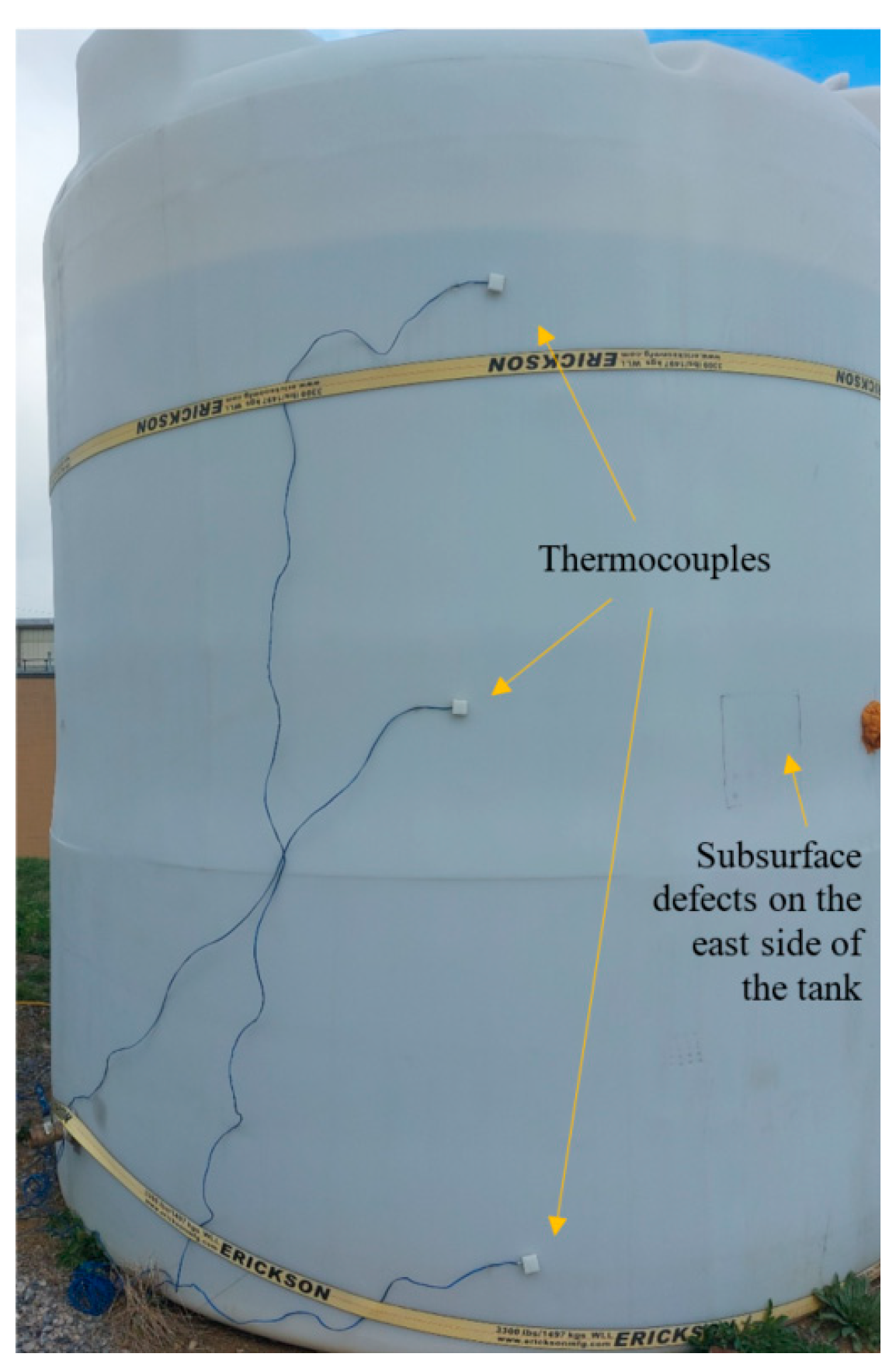
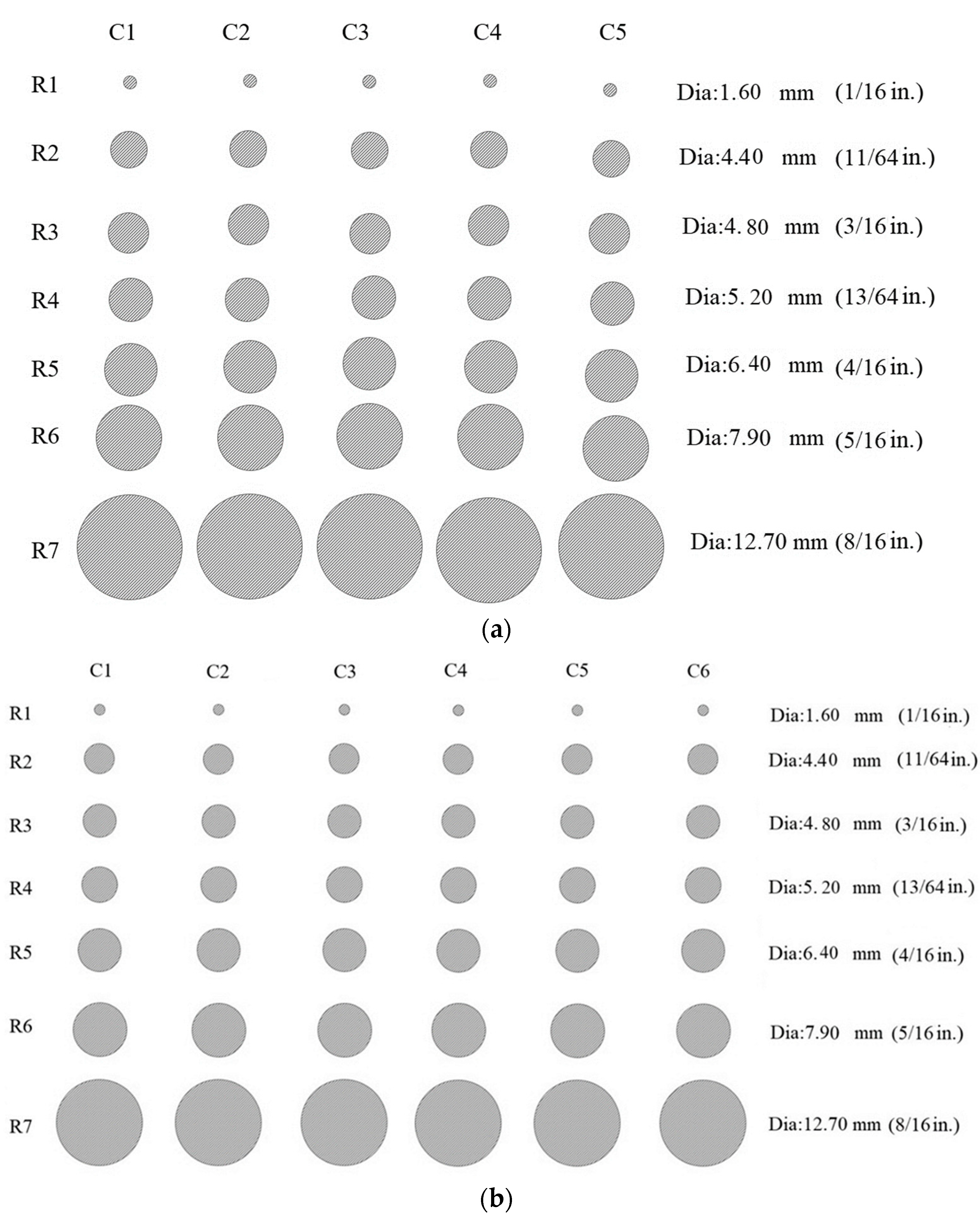




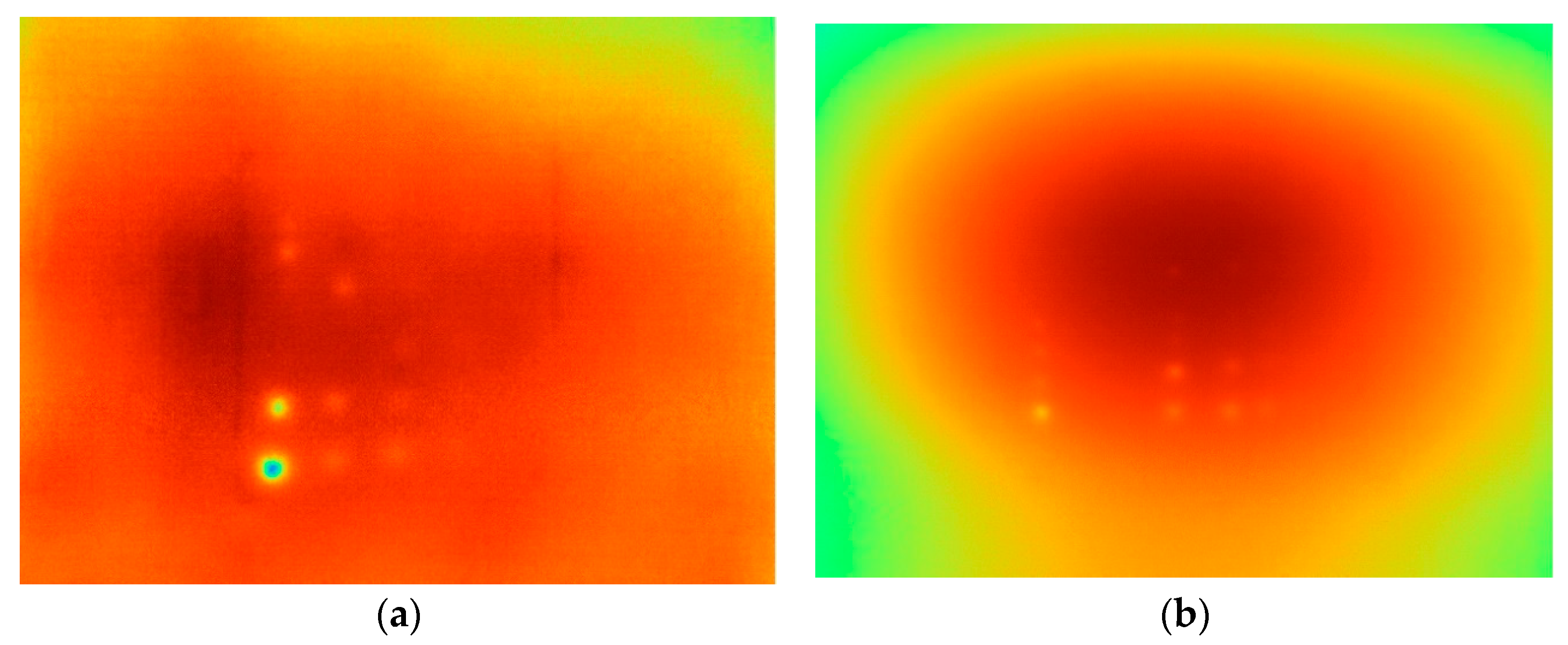


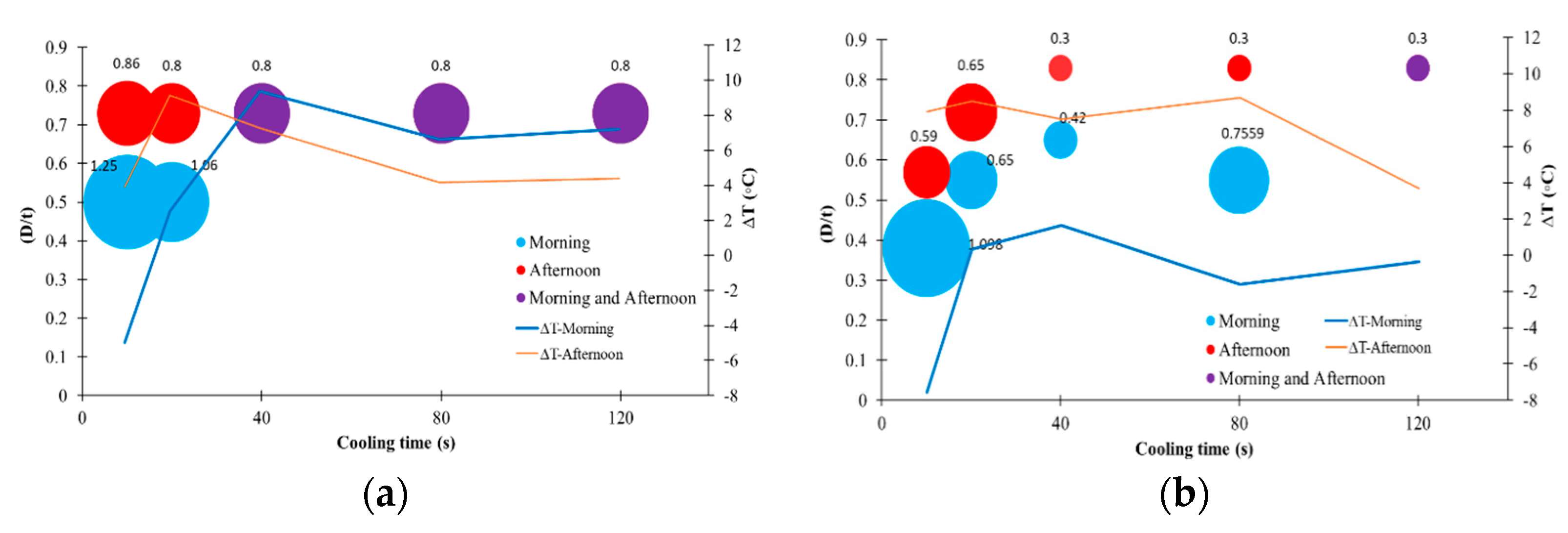
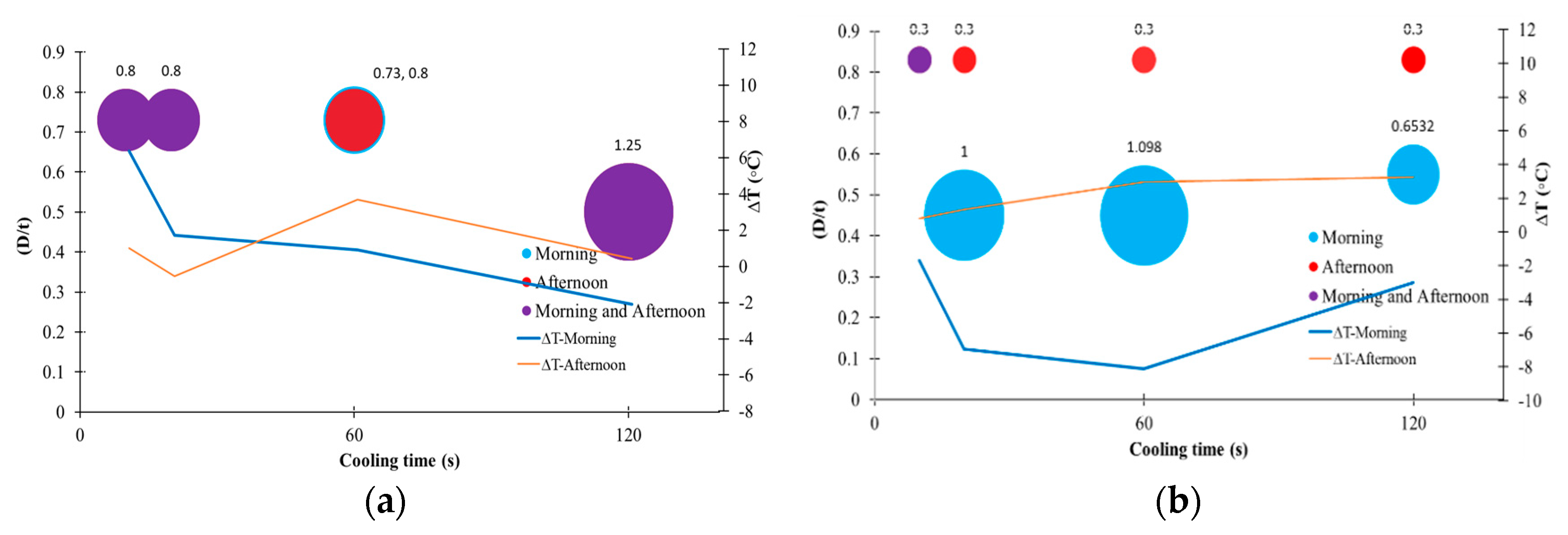

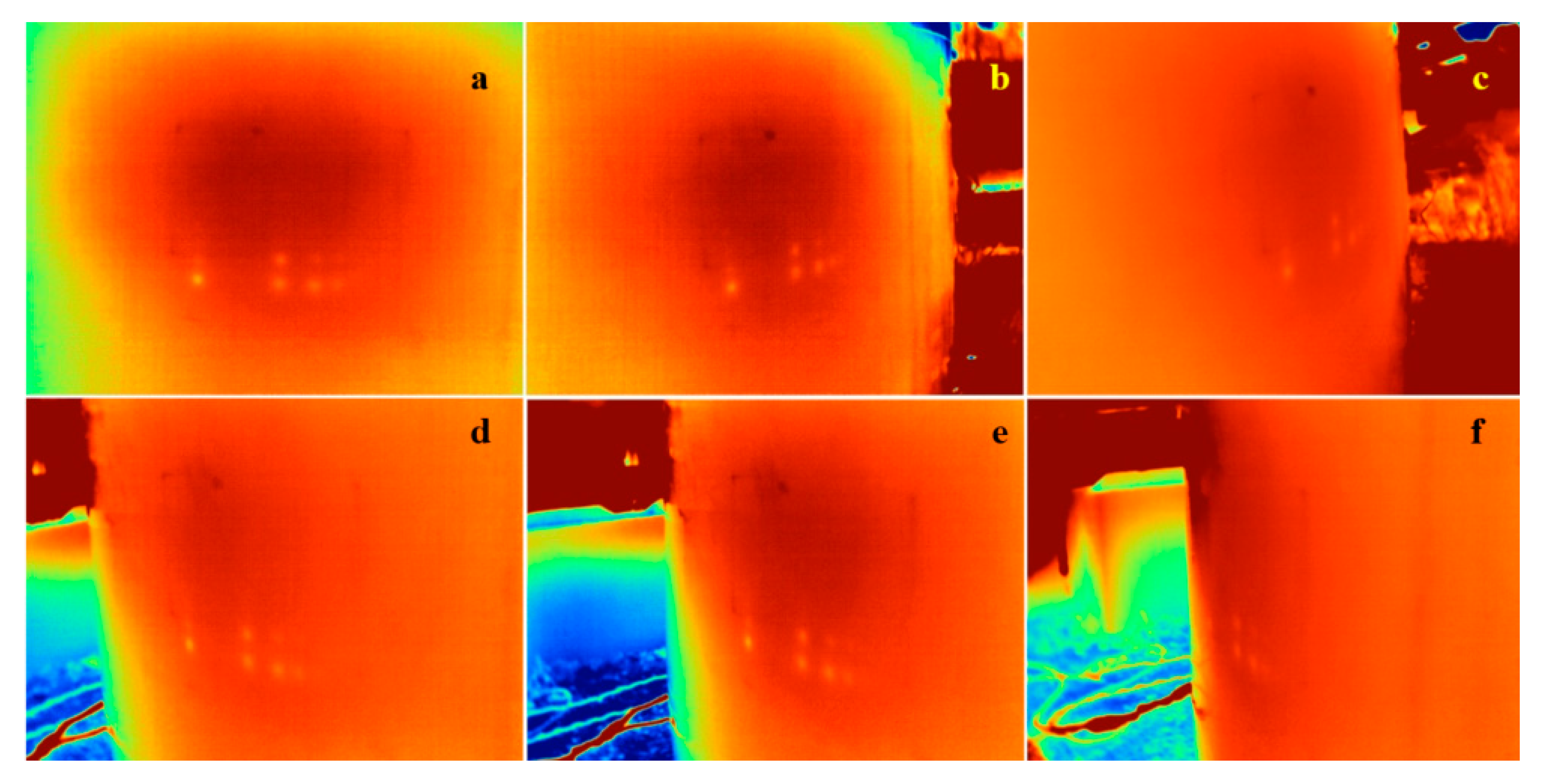
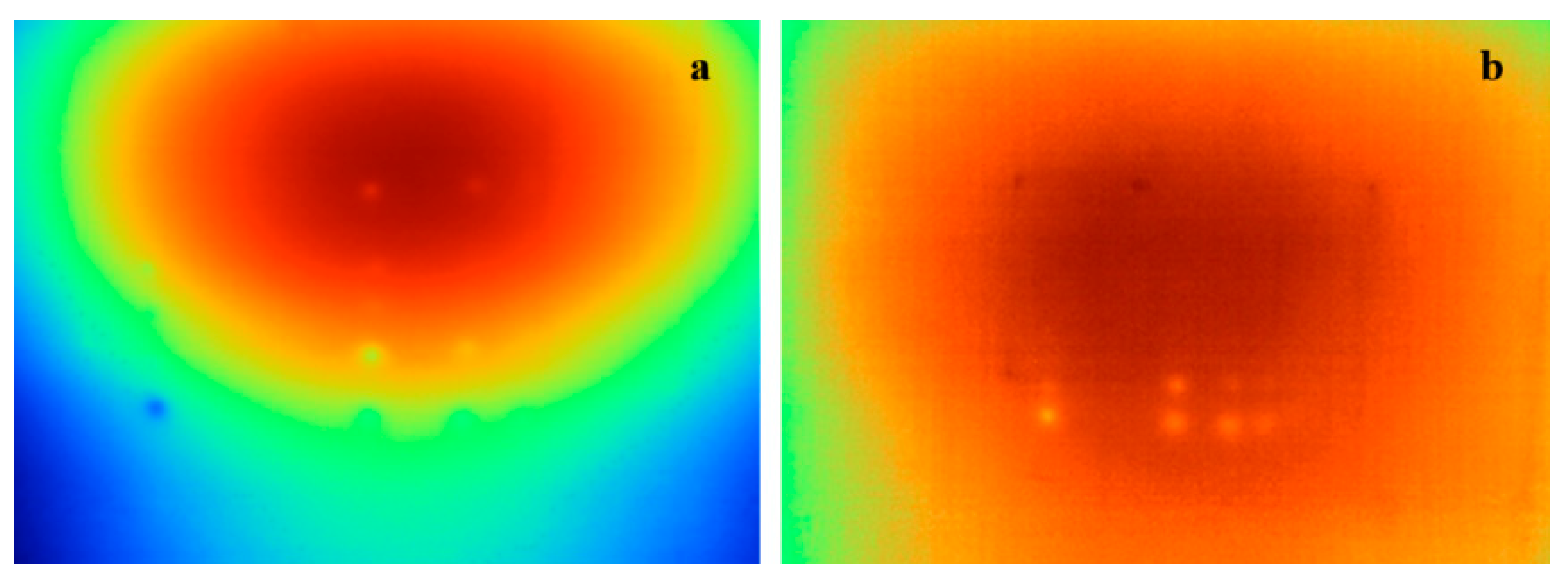
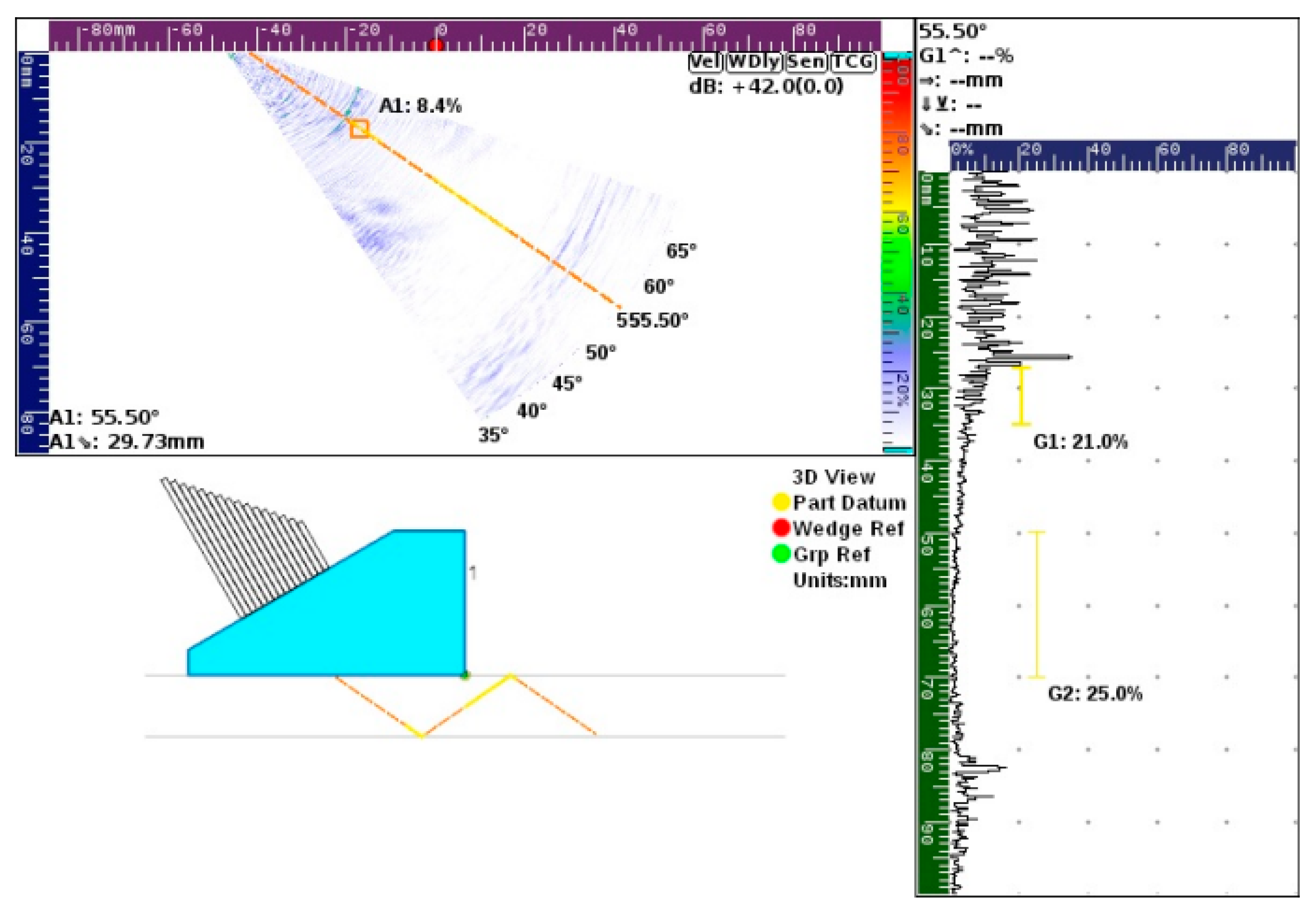
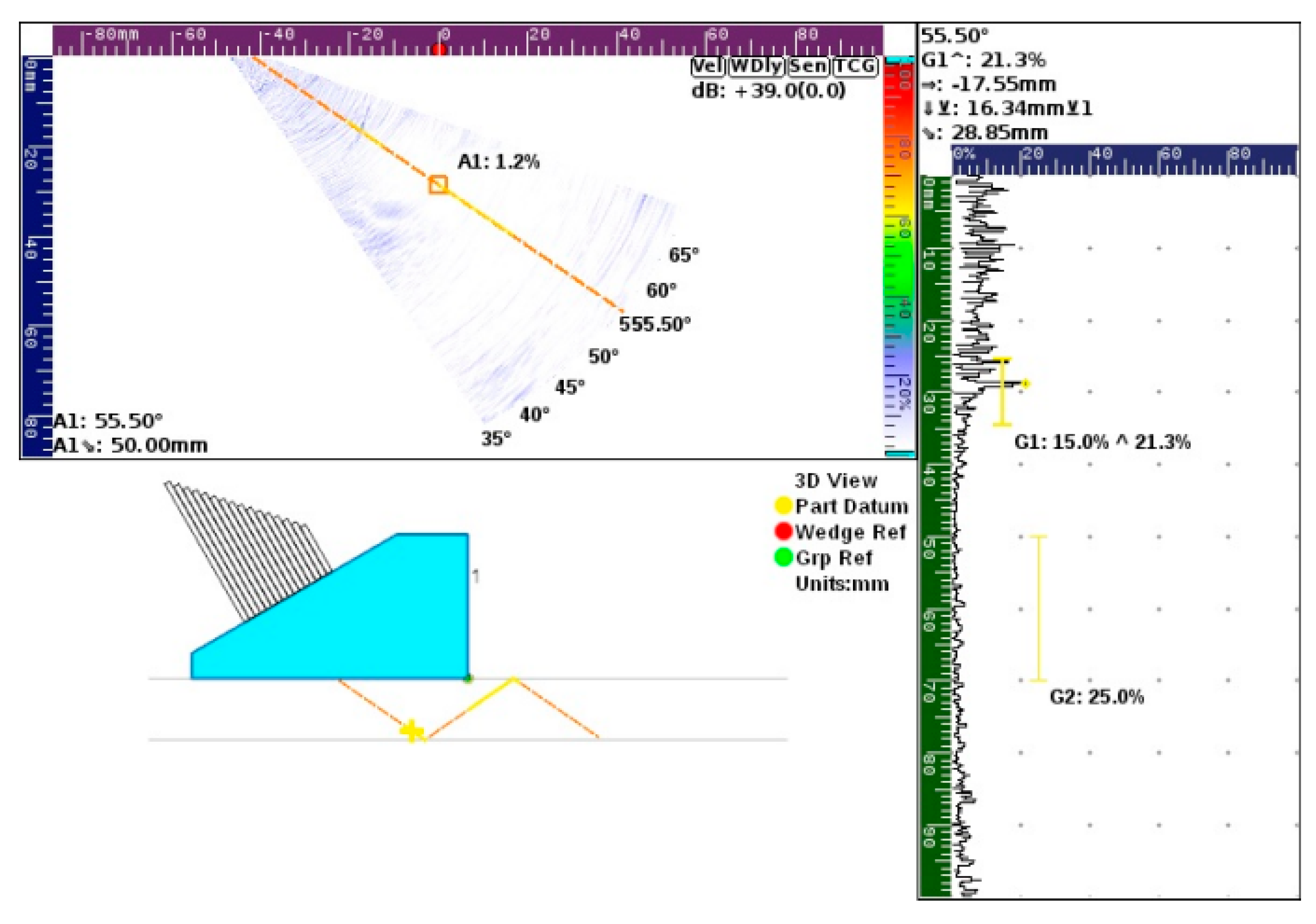
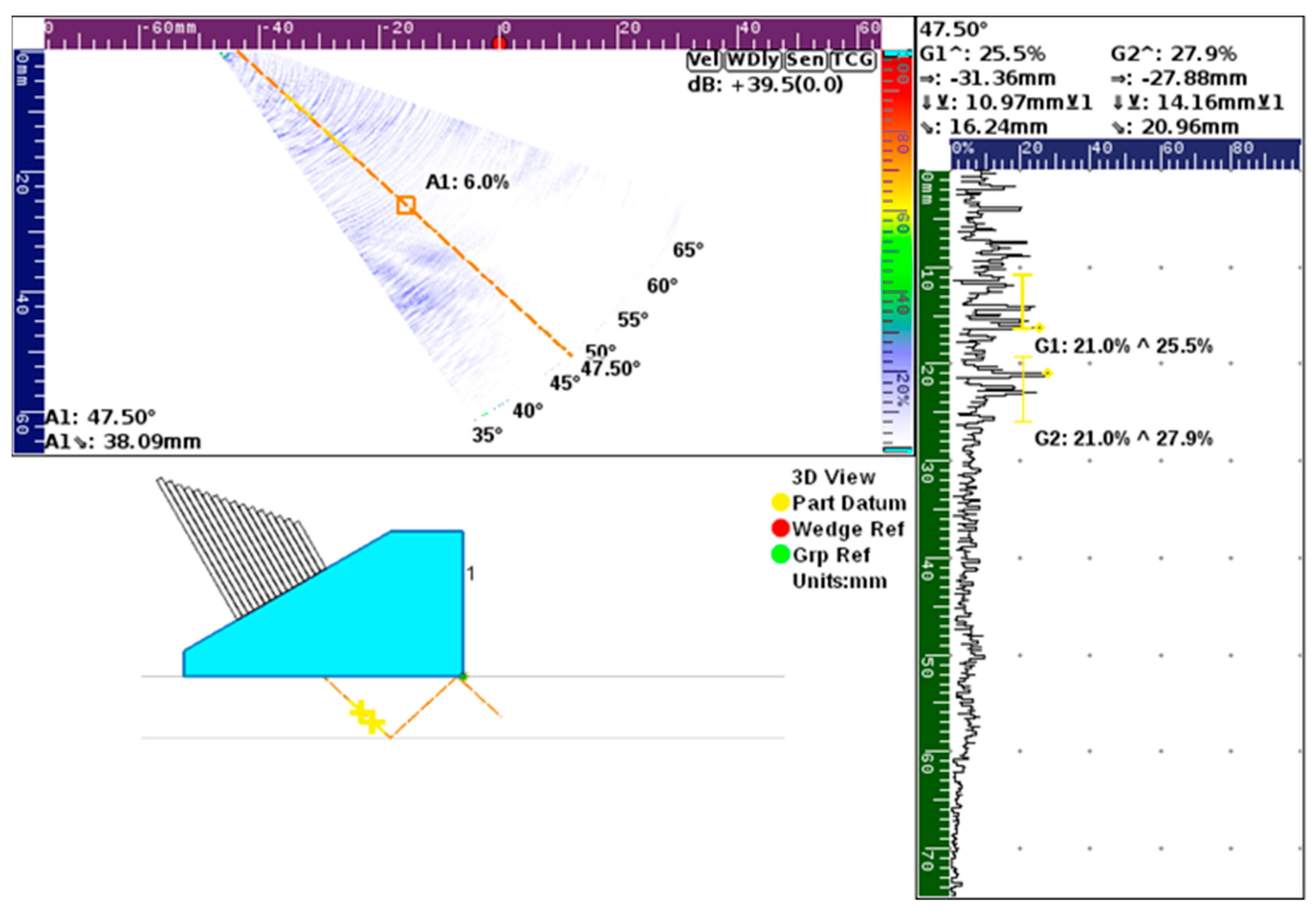
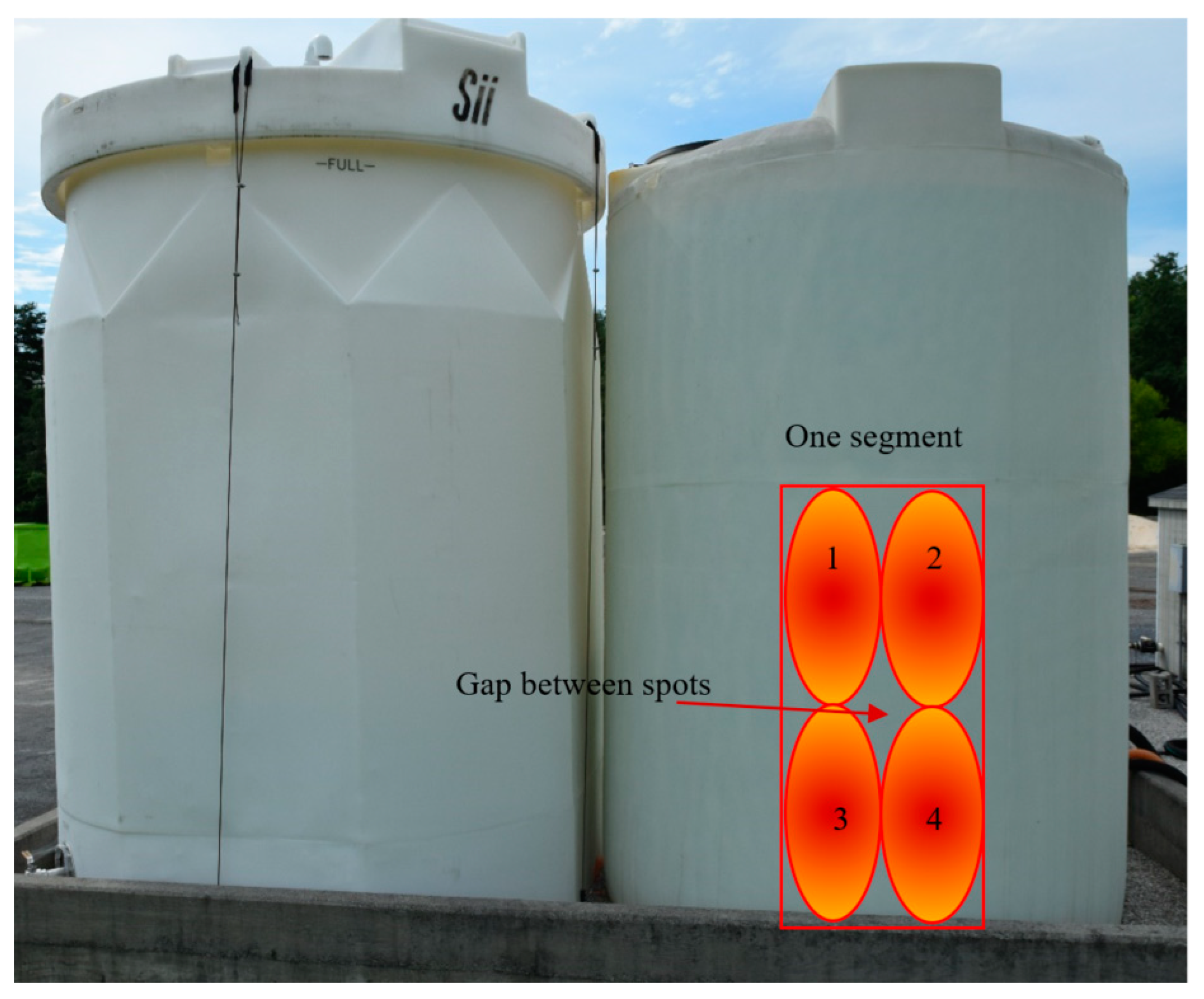
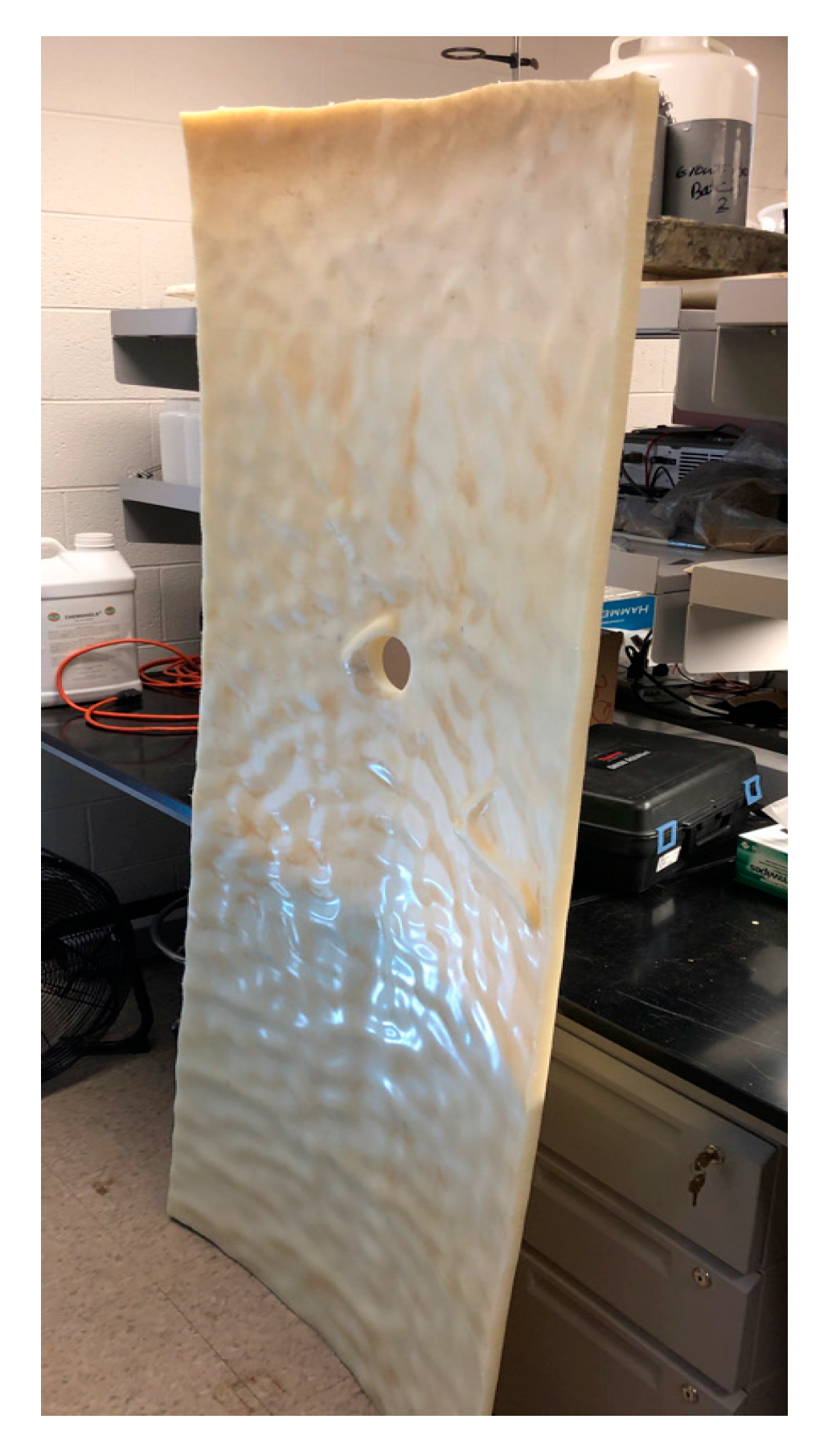
| Heating Time (s) | Cooling Time (s) | ||||||
|---|---|---|---|---|---|---|---|
| 20 | 10 | 20 | 40 | 60 | 80 | 100 | 120 |
| 30 | 10 | 20 | 30 | 60 | 90 | 120 | - |
| 40 | 10 | 20 | 40 | 80 | 120 | - | - |
| 60 | 10 | 20 | 60 | 120 | - | - | - |
| Detector resolution | 640 × 480 (307,200 pixels) |
| Field of view | 34 °H × 24 °V |
| Temperature measurement range | −20 °C to 1000 °C (−4 °F to 1832 °F) |
| Accuracy | ±2 °C or 2% (whichever is greater) |
| Thermal sensitivity (NETD) | ≤0.05 °C at 30 °C target temp (50 mK) |
| Frame rate | 60 Hz |
| Infrared spectral band | 7.5 μm to 14 μm (long wave) |
| Emissivity | 0.78 |
| Background | 23 °C (73 °F) |
| Transmission | 100% |
| Range | −20 °C to 100 °C (−4 °F to 212 °F) |
| Voltage mono | 100 V |
| Mono pulse damping | 50 ohms |
| Pulse type | Spike |
| Probe diameter | 12.7 mm (0.5 in) |
| Reference amplitude | 80.0% |
| Range path | 100 mm (4 in) |
| Travel mode | Half path |
| Acquired frequency | 100 MHz |
| Defects | Diameter (mm) | C1 | C2 | C3 | C4 | C5 | C6 | ||||||||||||
|---|---|---|---|---|---|---|---|---|---|---|---|---|---|---|---|---|---|---|---|
| Depth 1 | AR 2 | D/t 3 | Depth | AR | D/t | Depth | AR | D/t | Depth | AR | D/t | Depth | AR | D/t | Depth | AR | D/t | ||
| R1 | 1.6 | N/A 4 | N/A | N/A | N/A | N/A | N/A | N/A | N/A | N/A | N/A | N/A | N/A | N/A | N/A | N/A | N/A | N/A | N/A |
| R2 | 4.4 | 2.65 | 1.64 | 0.21 | 6.41 | 0.68 | 0.51 | 8.26 | 0.53 | 0.65 | 9.83 | 0.44 | 0.77 | 11.48 | 0.38 | 0.90 | N/A | N/A | N/A |
| R3 | 4.8 | 2.54 | 1.88 | 0.20 | 7.49 | 0.64 | 0.59 | 9.44 | 0.50 | 0.74 | 10.99 | 0.430 | 0.87 | 11.71 | 0.41 | 0.92 | N/A | N/A | N/A |
| R4 | 5.2 | 3.86 | 1.34 | 0.30 | 1.22 | 4.23 | 0.10 | 6.29 | 0.82 | 0.50 | 10.68 | 0.48 | 0.84 | 11.34 | 0.45 | 0.89 | N/A | N/A | N/A |
| R5 | 6.4 | 2.54 | 2.50 | 0.20 | 6.01 | 1.06 | 0.47 | 4.72 | 1.34 | 0.37 | 7.92 | 0.80 | 0.62 | 11.44 | 0.55 | 0.90 | N/A | N/A | N/A |
| R6 | 7.9 | 2.03 | 3.91 | 0.16 | 2.87 | 2.77 | 0.23 | 6.34 | 1.25 | 0.50 | 9.21 | 0.86 | 0.73 | 11.13 | 0.71 | 0.88 | N/A | N/A | N/A |
| R7 | 12.7 | 1.27 | 10 | 0.10 | 6.30 | 2.02 | 0.50 | 6.27 | 2.02 | 0.49 | 9.28 | 1.37 | 0.73 | 10.46 | 1.21 | 0.82 | N/A | N/A | N/A |
| Defects | Diameter (mm) | C1 | C2 | C3 | C4 | C5 | C6 | ||||||||||||
|---|---|---|---|---|---|---|---|---|---|---|---|---|---|---|---|---|---|---|---|
| Depth 1 | AR 2 | D/t 3 | Depth | AR | D/t | Depth | AR | D/t | Depth | AR | D/t | Depth | AR | D/t | Depth | AR | D/t | ||
| R1 | 1.6 | N/A 4 | N/A | N/A | N/A | N/A | N/A | N/A | N/A | N/A | N/A | N/A | N/A | N/A | N/A | N/A | N/A | N/A | N/A |
| R2 | 4.4 | 10.40 | 0.42 | 0.55 | 9.47 | 0.46 | 0.50 | 12.51 | 0.35 | 0.66 | 14.59 | 0.30 | 0.77 | 17.35 | 0.25 | 0.91 | 18.27 | 0.24 | 0.96 |
| R3 | 4.8 | 15.85 | 0.30 | 0.83 | 3.14 | 1.52 | 0.16 | 2.30 | 2.07 | 0.12 | 7.19 | 0.66 | 0.38 | 13.87 | 0.34 | 0.73 | 10.03 | 0.47 | 0.53 |
| R4 | 5.2 | 1.98 | 2.61 | 0.10 | 6.53 | 0.79 | 0.34 | 7.90 | 0.65 | 0.41 | 12.30 | 0.42 | 0.65 | 16.14 | 0.32 | 0.85 | 17.61 | 0.29 | 0.92 |
| R5 | 6.4 | 4.34 | 1.46 | 0.23 | 6.32 | 1.00 | 0.33 | 9.07 | 0.70 | 0.48 | 10.82 | 0.59 | 0.57 | 12.48 | 0.51 | 0.66 | 16.04 | 0.40 | 0.84 |
| R6 | 7.9 | 7.23 | 1.10 | 0.38 | 4.23 | 1.88 | 0.22 | 6.26 | 1.27 | 0.33 | 10.50 | 0.76 | 0.55 | 13.10 | 0.61 | 0.69 | 16.61 | 0.48 | 0.87 |
| R7 | 12.7 | 3.97 | 3.20 | 0.21 | 6.26 | 2.03 | 0.33 | 6.67 | 1.91 | 0.35 | 8.53 | 1.49 | 0.45 | 13.63 | 0.93 | 0.72 | 17.03 | 0.75 | 0.89 |
| Distance (m (ft)) | Maximum D/t | Minimum AR | Area under Evaluation (m2 (ft2)) |
|---|---|---|---|
| 0.75 (2.5) | 0.73 | 0.80 | 0.15 (1.6) |
| 1.0 (3.3) | 0.73 | 0.80 | 0.26 (2.8) |
| 1.3 (4.3) | 0.73 | 0.80 | 0.44 (4.7) |
| 2.0 (6.6) | 0.50 | 1.25 | 0.98 (10.6) |
| 2.3 (7.5) | 0.50 | 1.25 | 1.66 (17.9) |
| 3.0 (9.8) | 0.50 | 2.01 | 2.22 (23.9) |
| Wall Thickness (mm (in.)) | ∆T (°C (°F)) | Heating–Cooling Durations (s) |
|---|---|---|
| 12.7 (0.5) | ∆T > 6 (10.8) | 30–90 |
| 12.7 (0.5) | 6 (10.8) > ∆T ≥ 0 (0) | 60–20 or 60–60 |
| 12.7 (0.5) | 0 (0) > ∆T | Do not perform the evaluation |
| 19.1 (0.75) | ∆T > 4 (7.2) | 40–40 or 40–80 or 40–120 |
| 19.1 (0.75) | 4 (7.2) > ∆T ≥ 0 (0) | 60–20 or 60–60 |
| 19.1 (0.75) | 0 (0) > ∆T | Do not perform the evaluation |
| Tank Capacity (gal (L)) | Tank Age (Years) | Tank Type | Wall Thickness (mm, (in)) | Tank Diameter (m, (ft)) | Empty/Full |
|---|---|---|---|---|---|
| 5000 (18,900) | 12 | Single wall | 19.1 (0.75) | 2.60 (103) | Empty |
| 5000 (18,900) | 17 | Single wall | 19.1 (0.75) | 2.60 (103) | Full |
Disclaimer/Publisher’s Note: The statements, opinions and data contained in all publications are solely those of the individual author(s) and contributor(s) and not of MDPI and/or the editor(s). MDPI and/or the editor(s) disclaim responsibility for any injury to people or property resulting from any ideas, methods, instructions or products referred to in the content. |
© 2023 by the authors. Licensee MDPI, Basel, Switzerland. This article is an open access article distributed under the terms and conditions of the Creative Commons Attribution (CC BY) license (https://creativecommons.org/licenses/by/4.0/).
Share and Cite
Behravan, A.; Tran, T.Q.; Li, Y.; Davis, M.; Shaikh, M.S.; DeJong, M.M.; Hernandez, A.; Brand, A.S. Field Inspection of High-Density Polyethylene (HDPE) Storage Tanks Using Infrared Thermography and Ultrasonic Methods. Appl. Sci. 2023, 13, 1396. https://doi.org/10.3390/app13031396
Behravan A, Tran TQ, Li Y, Davis M, Shaikh MS, DeJong MM, Hernandez A, Brand AS. Field Inspection of High-Density Polyethylene (HDPE) Storage Tanks Using Infrared Thermography and Ultrasonic Methods. Applied Sciences. 2023; 13(3):1396. https://doi.org/10.3390/app13031396
Chicago/Turabian StyleBehravan, Amir, Thien Q. Tran, Yuhao Li, Mitchell Davis, Mohammad Shadab Shaikh, Matthew M. DeJong, Alan Hernandez, and Alexander S. Brand. 2023. "Field Inspection of High-Density Polyethylene (HDPE) Storage Tanks Using Infrared Thermography and Ultrasonic Methods" Applied Sciences 13, no. 3: 1396. https://doi.org/10.3390/app13031396
APA StyleBehravan, A., Tran, T. Q., Li, Y., Davis, M., Shaikh, M. S., DeJong, M. M., Hernandez, A., & Brand, A. S. (2023). Field Inspection of High-Density Polyethylene (HDPE) Storage Tanks Using Infrared Thermography and Ultrasonic Methods. Applied Sciences, 13(3), 1396. https://doi.org/10.3390/app13031396










